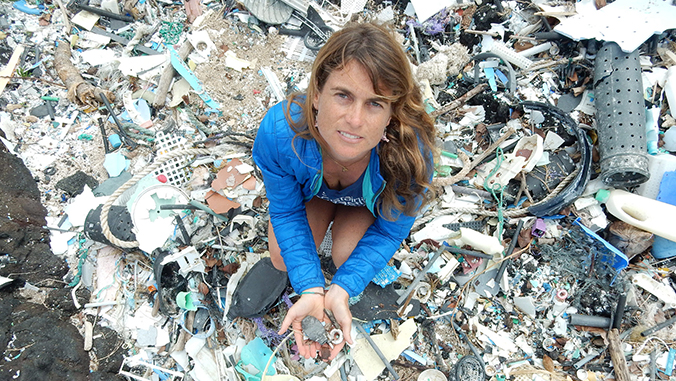Several greenhouse gases are emitted as common plastics degrade in the environment, according to researchers from the University of Hawaiʻi at Mānoa School of Ocean and Earth Science and Technology (SOEST).
Mass production of plastics started nearly 70 years ago, and the production rate is expected to double over the next two decades. While serving many applications because of their durability, stability and low cost, plastics have a negative impact on the environment. Plastic is known to release a variety of chemicals during degradation, some of which negatively affect organisms and ecosystems.
What happens when plastic degrades?
The study, published in PLOS One, reports the unexpected discovery of the universal production of greenhouse gases methane and ethylene by the most common plastics when exposed to sunlight. The SOEST team tested polycarbonate, acrylic, polypropylene, polyethylene terephthalate, polystyrene, high-density polyethylene and low-density polyethylene (LDPE)—materials used to make food storage, textiles, construction materials and various plastic goods. Polyethylene, used in shopping bags, is the most produced and discarded synthetic polymer globally, and was found to be the most prolific emitter of both gases.
The team found that the emission rate of the gases from virgin pellets of LDPE increased during a 212-day experiment, and that LDPE debris found in the ocean also emitted greenhouse gases when exposed to sunlight. Once exposed to solar radiation, the emission of these gases continued in the dark.
“We attribute the increased emission of greenhouse gases with time from the virgin pellets to photo-degradation of the plastic, as well as the formation of a surface layer marked with fractures, micro-cracks and pits,” said lead author Sarah-Jeanne Royer, a post-doctoral scholar in the Center for Microbial Oceanography: Research and Education (C-MORE) during the study. “With time, these defects increase the surface area available for further photo-chemical degradation and therefore contribute to an acceleration of the rate of gas production.”
It is also known that smaller particles, termed “microplastics,” are eventually produced in the environment and may further accelerate gas production.
Connection to global climate change
“Plastic represents a source of climate-relevant trace gases that is expected to increase as more plastic is produced and accumulated in the environment,” said David Karl, senior author on the study, SOEST professor and C-MORE director. “This source is not yet budgeted for when assessing global methane and ethylene cycles, and may be significant.”
Greenhouse gases directly influence climate change—affecting sea level, global temperatures, ecosystem health on land and in the ocean, and storms, which increase flooding, drought and erosion.
“Considering the amounts of plastic washing ashore on our coastlines, and the amount of plastic exposed to ambient conditions, our finding provides further evidence that we need to stop plastic production at the source, especially single-use plastic,” said Royer.
Royer is now working to develop estimates of the amount of plastic exposed to the environment in oceanic and terrestrial regions, globally, in order to constrain the overall greenhouse gas emissions from plastics.
See more images of of the microplastic research.
—By Marcie Grabowski


